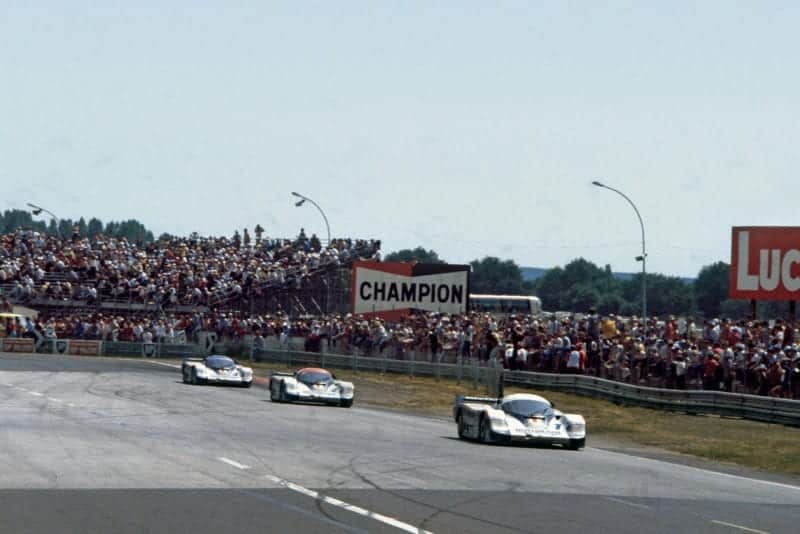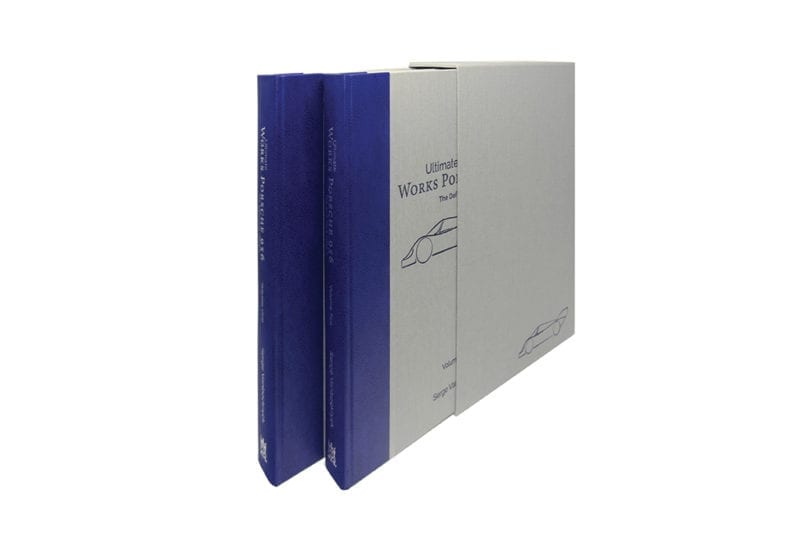An ode to the Porsche 956
A new, definitive work sets a benchmark for a legendary racing car, says Damien Smith

Porsche 956
Motorsport images
Serge Vanbockryck is just the man you need at Le Mans when it’s 2am. Corvette Racing’s long-time PR co-ordinator is great company – and it doesn’t hurt that he’s quick to offer good, strong coffee in the team’s suite directly above its pit. Naturally, conversation tends to centre around the race playing out around us, but in the wee small hours it rarely takes long to be diverted by stories of past Le Mans. The Belgian, a former journalist for whom sports car racing has always been his choix du jour, has always professed to an unnatural obsession with Porsche’s 956/962, the model variants that dominated the glorious Group C era of the 1980s. We knew he was working on a book, but in all honesty I was starting to wonder whether Serge would ever finish it, never mind get it published. But finally here it is – or at least half of it.
This eye-wateringly priced two-volume slip-cased heavyweight (limited to 956 copies) is the latest addition to the Porter Press ‘Ultimate’ series. More than 300,000 words over 800 pages… and it’s only part of the story, focusing just on the 956, and then only the Rothmans-backed factory entries. More is promised on the 962 years – so you could say Serge really does like these cars.
He knows his stuff, too. ‘Definitive’ is a word bandied about out all too often in our world, but it’s hard to argue in this case. Volume one offers context with an overview of Porsche’s racing history up to the 956’s 1982 debut, and it’s in-depth enough to be a strong standalone book in its own right. Eventually the 956 story begins, with conception, design and build, before the racing history and almost constant development are tackled.

The 956 shone brightest at Le Mans in 1982, where it secured a podium clean sweep
Motorsport images
Volume two takes the ‘works’ race story up to 1985, the transition season when the heavily revised 962 supplanted the 956. Then there are driver profiles of the 11 factory drivers, plus legendary architect Norbert Singer and race engineer Roland Kussmaul, followed by minutely detailed chassis histories and an interesting coda on Rothmans sponsorship and the tobacco company’s motor sport TV work by commentator Mark Cole. The photography is fantastic, many previously unseen, and the production qualities are top notch – just as you’d demand. And pleasingly, Serge’s signature brand of droll humour translates nicely to make the narrative easy and engaging.
The level of research, conducted over 30 years, is profound and the detail surrounding the conception of the 956 is particularly diverting. How the 956 found its shape in the wind tunnel, using 1:5-scale models, is classic, expert, old-school craftsmanship. Today, its contours and profile would be defined (and confined) by CFD. Back in August 1981, 87 different model variants coded CA were created and tested in just five days.
As photos show, the first featured a catamaran-style nose section that is strikingly similar to the LMP1 cars of our modern era, before Singer and his team reverted to convention. It shows contemporary Formula 1 design influenced Porsche as it embarked on its maiden ground-effects racing car.
The analogue CA experiments set the direction, and over the months further scale models would hone the form of the 956. But, as a spread of simple profile illustrations neatly documents, final perfection is a state always out of reach, even with the greatest racing cars. The drawings show how the 956 shape-shifted throughout its active life, via windtunnel models dating from CB-78 on 16 September 1981, to CT-30 on 21 July 1983. Jurgen Barth, the first to drive a 956 and the man responsible for selling the many customer cars that made the model ubiquitous, admits in his foreword to being “amazed” at the author’s level of detail. But that only echoes the unrelenting commitment. It’s what this car deserves.
“Stefan Bellof was youthful, impulsive and seemingly incapable of harnessing his natural speed”
The race histories are similarly dense, thanks to primary and secondary sources. Much is familiar, but nuggets of detail elevate the reports. Take the account of Stefan Bellof’s fabled performance around the Nürburgring Nordschleife in 1983, when he set that lap in 6min 11.3sec, then spectacularly binned it in the race after losing control at Pflanzgarten. Team-mate Derek Bell’s lasting annoyance, not only at Bellof but also at the team’s indulgence of the young wunderkind, is well known.
“Stefan was youthful, impulsive and seemingly incapable of harnessing his natural speed,” says a still brittle Bell. “We should have won this race rather than Jacky [Ickx] and Jochen [Mass]. Stefan threw it away.
“He emerged from the wreck all smiles, and laughed it off. What really annoyed me then, and, in many ways, it irritates me still, is that nobody in the Porsche management batted an eyelid. Nether Peter Falk nor Professor [Helmuth] Bott showed even any flicker of emotion.”
But the author then quotes from Falk’s autobiography to counter Bell’s view that Bellof had the management under a spell. “He was the first one who arrived with a manager and lawyer at Mr Bott’s to negotiate his contract,” Falk wrote. “This had irritated the good Bott no end, as before it had always been between just him and the drivers, casually and in confidence. What I didn’t like about Bellof [was] that he didn’t care about rules. When we asked him to test at Weissach he arrived in his 928 and was
proud he arrived five minutes faster than the time before.”
Little is as simple as it might at first seem. That’s why, when you care as much as Serge Vanbockryk, you do your homework – even if it takes three decades.

Porsche 956 book
Works Porsche 956
the Definitive History Serge Vanbockryk
Published by Porter Press International,
£450
ISBN 978-1-907085-98-7

